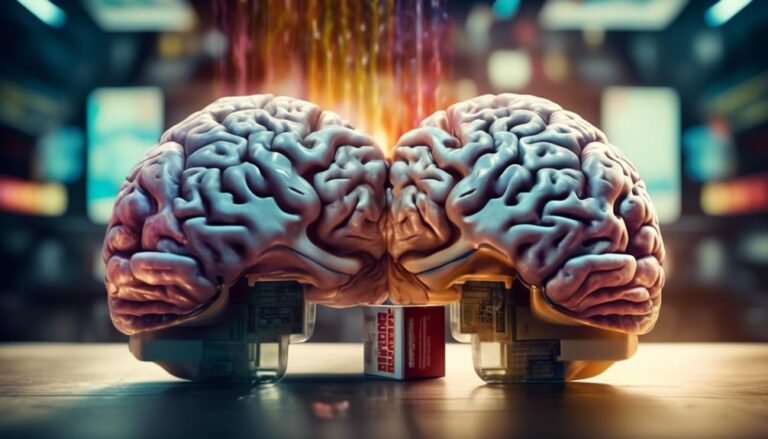Impact of Nostalgia in Marketing
You may have noticed that some brands have a way of tapping into your fond memories of the past. They skillfully evoke feelings of nostalgia, creating a sense of familiarity and connection with their consumers.
But have you ever wondered why nostalgia is such a powerful tool in marketing? How does it influence your perception of a brand?
In this discussion, we will explore the impact of nostalgia in marketing and unravel the secrets behind its effectiveness. Prepare to journey back in time as we uncover the hidden potential of nostalgia in shaping consumer behavior.
Key Takeaways
- Nostalgic marketing trends are gaining traction and have the power to make people feel happier.
- Nostalgia increases willingness to spend money and strengthens loyalty to a brand.
- Emotional connection is essential for building relationships and brand loyalty, and nostalgia taps into consumers' fond memories and evokes positive emotions.
- Leveraging cultural references, such as music, movies, and fashion, creates an emotional connection with consumers and associates brands with positive memories and experiences.
The Power of Nostalgia
The power of nostalgia lies in its ability to evoke strong emotions and create a sense of connection between consumers and brands. Nostalgic marketing trends have gained significant traction in recent years, as companies recognize the psychological impact that nostalgia can have on consumers. Research shows that nostalgia can make people feel happier, increase their willingness to spend money, and strengthen their loyalty to a brand.
When consumers experience nostalgia, it triggers positive emotions and memories associated with the past. This emotional response can lead to a deeper connection with a brand, as it taps into individuals' personal experiences and creates a sense of familiarity and comfort. By incorporating elements from the past, such as retro designs, vintage advertisements, or iconic slogans, brands can evoke nostalgia and strengthen their bond with consumers.
Furthermore, studies have found that nostalgia can enhance the perceived quality of products and increase consumers' willingness to pay a higher price. This is because nostalgia not only reminds people of positive experiences but also makes them feel more connected to their own identity and values. As a result, consumers are more likely to trust and prefer brands that evoke nostalgic emotions.
Emotional Connection With Consumers
Creating an emotional connection with consumers is essential for building long-lasting relationships and driving brand loyalty. Consumer psychology studies have shown that emotions play a significant role in decision-making processes. Emotional marketing, therefore, aims to tap into these emotions to create a deeper connection between the consumer and the brand.
When consumers feel emotionally connected to a brand, they're more likely to develop brand loyalty, which can lead to repeat purchases and positive word-of-mouth recommendations. Research has found that consumers are willing to pay a premium for brands that evoke positive emotions and make them feel connected on a personal level.
Emotional marketing strategies can take many forms, such as storytelling, nostalgia, and personalization. By telling compelling stories that resonate with consumers' emotions and values, brands can create a sense of identification and build trust.
Nostalgia, in particular, has proven to be a powerful tool in emotional marketing, as it taps into consumers' fond memories and evokes positive emotions. By using nostalgic elements in their marketing campaigns, brands can trigger feelings of happiness, familiarity, and comfort, which can strengthen the emotional connection with consumers.
Building Brand Familiarity
To further enhance the emotional connection and drive brand loyalty, it's important for marketers to focus on building brand familiarity with consumers. Brand familiarity refers to the level of recognition and knowledge that consumers have about a particular brand. When consumers are familiar with a brand, they feel more comfortable and confident in their purchasing decisions, leading to increased brand loyalty.
Consumer psychology plays a crucial role in building brand familiarity. Research has shown that consumers are more likely to choose familiar brands over unfamiliar ones. This is because familiarity creates a sense of trust and reduces perceived risk. When consumers are familiar with a brand, they develop positive associations and memories associated with it, which strengthens their emotional connection to the brand.
Marketers can build brand familiarity through various strategies. One effective way is through consistent branding and messaging across different touchpoints. By using the same logo, colors, and language, marketers can create a cohesive brand identity that consumers can easily recognize and recall. Additionally, creating memorable experiences through advertising, packaging, and customer interactions can also contribute to building brand familiarity.
Eliciting Positive Memories
One effective method for building brand familiarity and strengthening emotional connections is by eliciting positive memories in consumers. Positive emotions play a significant role in creating a personal connection between consumers and brands. By tapping into nostalgia, marketers can evoke fond memories from the past, triggering positive emotions that enhance consumer engagement and loyalty.
Numerous studies have shown that nostalgia evokes positive emotions such as happiness, joy, and warmth. When consumers experience positive emotions, they're more likely to form a personal connection with a brand. This connection is crucial for building trust and loyalty, as it fosters a sense of familiarity and comfort.
To elicit positive memories, marketers can use various strategies. One approach is incorporating nostalgic elements into advertising campaigns, such as using retro designs, vintage music, or references to past pop culture. Another tactic is to leverage storytelling, sharing narratives that resonate with consumers' personal experiences and transport them back to a positive time in their lives.
Nostalgic Advertising Techniques
By leveraging nostalgia, marketers can employ various techniques in their advertising campaigns to evoke positive memories and forge stronger emotional connections with consumers. Nostalgic branding is a powerful tool that taps into the consumers' longing for the past and their emotional attachment to certain time periods, products, or experiences. This technique involves incorporating elements from the past, such as retro designs, vintage packaging, or iconic slogans, to evoke a sense of familiarity and nostalgia. Emotional marketing, on the other hand, focuses on creating advertisements that elicit emotional responses from consumers. This could involve telling heartfelt stories, showcasing sentimental moments, or using music and visuals that evoke strong emotions.
To help illustrate the impact of these techniques, consider the following table:
| Nostalgic Branding Techniques | Emotional Marketing Techniques | Examples |
|---|---|---|
| Retro designs and packaging | Heartfelt storytelling | Coca-Cola's Christmas ads |
| Iconic slogans | Sentimental moments | Google's "Parisian Love" ad |
| Vintage imagery | Evoking strong emotions | John Lewis' Christmas ads |
Leveraging Cultural References
Leveraging cultural references in marketing allows brands to tap into popular trends and connect with consumers on an emotional level.
By incorporating elements of pop culture, such as music, movies, and fashion, marketers can evoke feelings of nostalgia and create a sense of familiarity and relatability.
This strategy not only helps to establish a stronger emotional connection with consumers but also enables brands to associate themselves with positive memories and experiences, ultimately influencing purchasing decisions.
Pop Culture References
Utilizing cultural references in marketing campaigns can effectively tap into consumers' nostalgia, creating a sense of familiarity and connection with the brand. When it comes to pop culture influences and nostalgia marketing trends, incorporating popular references can be a powerful tool.
Here are three ways in which leveraging pop culture references in marketing can have a significant impact:
- Increased brand recognition: By referencing well-known pop culture icons or moments, marketers can generate immediate recognition and recall among consumers, helping to build brand awareness.
- Emotional connection: Pop culture references often evoke strong emotions and memories, allowing brands to connect with consumers on a deeper level. This emotional connection can lead to increased customer loyalty and brand affinity.
- Viral potential: Incorporating pop culture references in marketing campaigns can make them more shareable and increase their potential to go viral. Consumers are more likely to engage with and share content that resonates with their pop culture interests, leading to greater exposure for the brand.
Emotional Connection
Cultural references in marketing campaigns can foster a deep emotional connection with consumers, resulting in increased brand loyalty and affinity. Leveraging emotional storytelling techniques and understanding consumer psychology are key to achieving this connection.
Emotional storytelling involves crafting narratives that evoke specific emotions, such as nostalgia, happiness, or even sadness, to resonate with consumers on a deeper level. By tapping into shared cultural references, brands can create a sense of familiarity and belonging, making consumers feel understood and valued.
This emotional connection enhances brand perception and loyalty, as consumers are more likely to develop a strong attachment to brands that evoke positive emotions and memories. Furthermore, understanding consumer psychology allows marketers to align their campaigns with consumers' desires and aspirations, strengthening the emotional bond and driving long-term loyalty.
Brand Association
Brands can foster a strong emotional connection with consumers by incorporating cultural references into their marketing campaigns. Leveraging cultural references helps create a sense of familiarity and nostalgia, which can lead to increased brand loyalty and engagement.
Here are three ways brands can effectively leverage cultural references in their marketing:
- Identify the target audience's cultural touchpoints: Understanding the cultural references that resonate with your target audience is crucial. Conducting consumer research and analyzing consumer psychology can help identify the cultural touchpoints that evoke nostalgia and emotional connection.
- Incorporate cultural references subtly: Rather than using cultural references in an overt and obvious manner, brands should aim for subtlety. Incorporating cultural references in a way that feels authentic and natural helps to create a stronger emotional connection with consumers.
- Stay relevant and up-to-date: Cultural references change over time, so it's important for brands to stay current and avoid outdated references. Keeping a pulse on popular culture and being aware of current trends ensures that brands can effectively leverage cultural references in their marketing campaigns and maintain consumer interest.
Nostalgia in Product Design
Product design that evokes nostalgia can have a powerful emotional impact on consumers. By incorporating design elements that remind people of their past, such as retro colors or vintage packaging, products can tap into a sense of familiarity and comfort.
This nostalgic aesthetic appeal can create a sense of trust and authenticity, making consumers more likely to connect with the product and make a purchase.
Emotional Design Impact
When designing products, incorporating nostalgic elements can have a powerful emotional impact on consumers. By tapping into consumer psychology, emotional design can create a strong emotional appeal that resonates with customers.
Here are three ways in which nostalgia in product design can have an emotional impact:
- Evoking positive memories: Nostalgic elements in product design can transport consumers back to a time when they felt happy and content. This can create a positive emotional connection and increase their affinity towards the product.
- Building trust and familiarity: Nostalgia can create a sense of familiarity and nostalgia for the past. This can build trust and a feeling of comfort with the product, making consumers more likely to choose it over alternatives.
- Creating a sense of belonging: Nostalgic elements can help consumers feel connected to a larger community or group, creating a sense of belonging. This emotional connection can foster loyalty and advocacy for the brand.
Nostalgic Aesthetic Appeal
Incorporating nostalgic elements in product design can evoke a strong emotional response from consumers, creating a sense of familiarity and connection.
This nostalgic aesthetic appeal has become increasingly popular in marketing, as brands tap into the power of nostalgia to attract and engage consumers.
Nostalgic fashion trends, such as vintage-inspired clothing and accessories, have gained significant traction in recent years. These trends allow consumers to relive the past and evoke positive memories associated with a particular era.
Similarly, vintage marketing campaigns that incorporate retro designs and imagery have been successful in capturing consumers' attention and generating positive brand associations.
Using Nostalgia in Social Media Marketing
To effectively engage your audience and evoke positive emotions, consider utilizing nostalgia in your social media marketing campaigns. Nostalgia has proven to be a powerful tool in digital advertising, creating a sense of familiarity and connection with your target audience.
Here are three ways you can incorporate nostalgia into your social media marketing strategy:
- Throwback Thursdays: Tap into the popular trend of Throwback Thursdays by sharing nostalgic photos, videos, or memories from the past. This allows your audience to reminisce and feel a sense of nostalgia, while also creating an opportunity for them to engage with your brand by sharing their own nostalgic moments.
- Retro-inspired content: Create content that pays homage to a specific era or time period that resonates with your target demographic. This could include using retro designs, fonts, or color schemes that evoke a sense of nostalgia. By incorporating these elements into your social media posts, you can capture the attention of your audience and create a connection with them.
- Nostalgic storytelling: Use storytelling to evoke emotions and create a sense of nostalgia. Share stories that highlight the history or evolution of your brand, or stories that relate to your audience's shared experiences. By tapping into their nostalgic memories, you can create a deeper connection and build brand loyalty.
Nostalgia as a Branding Strategy
Nostalgia can be a powerful branding strategy that taps into the emotions and memories of consumers. By incorporating nostalgia in storytelling, brands have the ability to create a strong emotional connection with their target audience. Research has shown that nostalgia evokes positive emotions and enhances the perception of product quality and value. When brands use nostalgia in their marketing campaigns, they're able to transport consumers back to a time when things were simpler and more familiar, creating a sense of comfort and familiarity.
Furthermore, nostalgia plays a significant role in customer loyalty. When consumers feel a sense of nostalgia towards a brand, they're more likely to develop a strong attachment and loyalty towards it. This emotional connection can lead to repeat purchases and increased customer lifetime value.
Brands can leverage nostalgia by incorporating elements from the past into their products, packaging, and advertising. By using retro designs, vintage themes, or referencing popular culture from a bygone era, brands can tap into consumers' fond memories and create a sense of nostalgia.
Measuring the Success of Nostalgic Campaigns
To measure the success of nostalgic campaigns, you can use various metrics to track consumer response and evaluate emotional resonance.
Metrics such as brand recall, customer engagement, and sales uplift can provide quantitative data on the effectiveness of nostalgic campaigns.
Additionally, qualitative measures like sentiment analysis and focus groups can offer insights into the emotional connection and nostalgia evoked by the campaign.
Metrics for Nostalgic Campaigns
Effective measurement of the success of nostalgic campaigns relies on robust metrics that capture consumer engagement and sentiment towards the brand or product. To accurately measure the effectiveness of these campaigns, it's essential to analyze consumer behavior and gather data through various metrics.
Here are three key metrics that can be used to measure the success of nostalgic campaigns:
- Engagement Metrics: Tracking metrics such as click-through rates, time spent on the website, and social media interactions can provide insights into the level of engagement consumers have with the nostalgic campaign.
- Sentiment Analysis: Analyzing consumer sentiment through sentiment analysis tools can help determine whether the nostalgic campaign is resonating positively or negatively with the target audience.
- Purchase Behavior: Monitoring sales data and analyzing changes in consumer purchasing patterns can indicate the impact of the nostalgic campaign on actual buying decisions.
Tracking Consumer Response
After analyzing the metrics for nostalgic campaigns, the next step is to track consumer response and measure the success of these campaigns.
Tracking consumer engagement is crucial in understanding the impact of nostalgic marketing. By monitoring consumer interactions, such as social media comments, likes, and shares, you can gauge the level of interest and involvement generated by the campaign.
Additionally, analyzing sentiment is essential in determining the overall perception of the nostalgic campaign. Sentiment analysis tools can help identify whether consumer sentiment is positive, negative, or neutral towards the campaign.
Evaluating Emotional Resonance
Measuring the success of nostalgic campaigns involves evaluating the emotional resonance they create among consumers. To determine the impact of nostalgia in marketing, it's essential to evaluate consumer sentiment and measure the emotional impact of these campaigns.
Here are three key factors to consider when evaluating emotional resonance:
- Survey data: Conducting surveys can provide valuable insights into consumer sentiment towards nostalgic campaigns. By asking specific questions about emotions and memories evoked by the campaign, marketers can gauge the emotional impact on consumers.
- Social media analysis: Analyzing social media mentions, comments, and shares related to nostalgic campaigns can offer a deeper understanding of how consumers connect emotionally with the content. Monitoring sentiment analysis and engagement metrics can provide valuable insights into the campaign's emotional resonance.
- Sales and brand metrics: Tracking sales and brand metrics can help measure the overall success of nostalgic campaigns. By comparing sales performance before, during, and after the campaign, marketers can evaluate the emotional impact on consumer behavior and brand perception.
Conclusion
As you journey through the world of marketing, nostalgia acts as a compass, guiding you towards the hearts and minds of your consumers. It holds the power to forge emotional connections, build brand familiarity, and elicit positive memories.
By incorporating nostalgic advertising techniques, product design, and social media strategies, you can create a branding strategy that resonates with your audience.
So, embark on this nostalgic adventure and measure the success of your campaigns as you navigate the path to marketing greatness.







